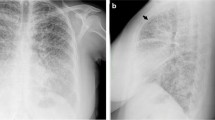Abstract.
Aspiration of barium sulfate occurs accidentally. Lung reaction is usually mild in the early phase due to inert character of the substance and long-term reactions or late toxicities are not expected. Little if any fibrotic response is speculated. We present a case with barium aspiration, studied by high-resolution computed tomography (HRCT) 1 year after the event, as late pulmonary sequelae studied by CT have not been described yet, to the best of our knowledge. The HRCT revealed thickened interlobular septa, subpleural lines, subpleural cysts, and centrilobular micronodules along with barium particles in a subpleural distribution. Those findings indicated that barium is capable of producing mild though silent clinically fibrosis.




Similar content being viewed by others
References
Rasley A, Logemann JA, Kahrilas PJ, Rademaker AW, Pauloski BR, Dodds WJ (1993) Prevention of barium aspiration during videofluoroscopic swallowing studies: value of change in posture. Am J Roentgenol 160:1005–1009
Tamm I, Kortsik C (1999) Severe barium sulfate aspiration into the lung: clinical presentation, prognosis and therapy. Respiration 66:81–84
Pracy JP, Montgomery PQ, Reading N (1993) Acute pneumonitis caused by low-density barium sulphate aspiration. J Laryngol Otol 107:347–348
Gray C, Sivaloganathan S, Simpkins KC (1989) Aspiration of high-density barium contrast medium causing acute pulmonary inflammation: report of two fatal cases in elderly women with disordered swallowing. Clin Radiol 40:397–400
Roggli VL, Shelburne JD (1988) Mineral pneumoconioses. In: Dail D, Hammar S (eds) Pulmonary pathology. Springer, Berlin Heidelberg New York, pp 589–617
Tsokos M, Schulz F, Vogel H (1998) Barium aspiration with fatal outcome. Aktuelle Radiol 8:201–203
Penington GR (1993) Severe complications following a "barium swallow" investigation for dysphagia. Med J Aust 159:764–765
McAlister WH, Askin FB (1983) The effects of some contrast agents in the lung: an experimental study in the rat and dog. Am J Roentgenol 140:245–251
Fraser R, Muller N, Colman N, Pare P (1999) Diagnosis of diseases of the chest, 4th edn. Saunders, Philadelphia
Cluzel P, Grenier P, Bernadac P, Laurent F, Picard JD (1991) Pulmonary alveolar microlithiasis: CT findings. J Comput Assist Tomogr 15:938–942
Hartman TE, Muller NL, Primack SL, Jokoh T, Takeuchi N, Ikezoe J, Swensen SJ (1994) Metastatic pulmonary calcification in patients with hypercalcemia: findings on chest radiographs and CT scans. Am J Roentgenol 162:799–802
Swensen SJ, Aughenbaugh GL, Douglas WW, Myers JL (1992) High-resolution CT of the lungs: findings in various pulmonary diseases. Am J Roentgenol 158:971–979
Schaefer-Prokop C, Prokop M, Fleishman D, Herold C (2001) High resolution CT of diffuse interstitial lung disease: key findings in common disorders. Eur Radiol 11:373–392
Akira M, Yamamoto S, Yokoyama K, Kita N, Morinaga K, Higashihara T, Kozuka T (1990) Asbestosis: high-resolution CT–pathologic correlation. Radiology 176:389–394
Author information
Authors and Affiliations
Corresponding author
Rights and permissions
About this article
Cite this article
Voloudaki, A., Ergazakis, N. & Gourtsoyiannis, N. Late changes in barium sulfate aspiration: HRCT features. Eur Radiol 13, 2226–2229 (2003). https://doi.org/10.1007/s00330-002-1687-5
Received:
Revised:
Accepted:
Published:
Issue Date:
DOI: https://doi.org/10.1007/s00330-002-1687-5




